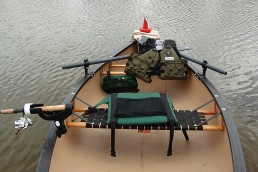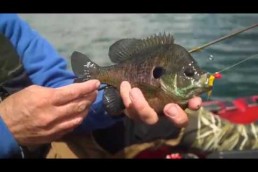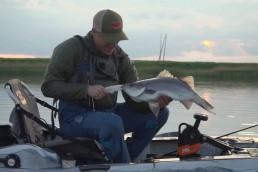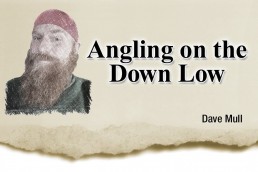Canoe or Kayak? Which Fits you better for Fishing?
SHARE THIS POST
Having made my annual pilgrimage to Canoecopia, I was amazed at the number of fishing kayaks that were presented. Now I will admit I’m an unabashed canoeist and probably fish as much from my canoe as my boat. But I’ve fished from kayaks and keep trying them, but I always come back to my trusty canoe. Knowing my bias, let me give you the pros and cons of each.
Comfort
For me, comfort is the first consideration. Most fishing kayaks are usually a sit-on-top style. This puts your center of gravity low and adds stability. You sit with legs bent or straight-out flat. You can only face forward, and twisting around to look behind is difficult. In a canoe, you sit higher, which is less stable but your legs are bent and you can squirm around easier. This is the biggest plus for me. My back goes spastic with that bent knee/straight leg position. In a canoe, I can squirm, wiggle, crouch or kneel and even stand to alleviate pressure on my lower back. In a canoe, I can also lower the webbed seat using 4-inch pieces of PVC pipe as spacers. This allows me to use a stadium-type seat with a back without raising my center of gravity.
Moving around
Propulsion is different for each craft. A kayak uses only a two-bladed paddle, and when not in use it’s usually balanced across the cockpit or has to be fastened along the deck. To move, you have to put down your pole and pick up the paddle. Make sure you use a tether on your paddle so it doesn’t escape. A canoe is propelled with a single-blade paddle that, when not in use, can be quickly dropped to the deck. I always have a long and short paddle or a double-bladed kayak paddle and a short single. The long paddle or double-blade is used for getting from place to place while the shorter one is used for one-handed maneuvering. A canoe also has the advantage of adding an electric trolling motor, if you wish. The newest rage is pedal- powered kayaks. These use pedals to drive two flippers and have the advantage of hands-free movement.
Weight and capacity
Weight is a consideration from a hauling standpoint. My 12-foot canoe weighs 23 pounds; my two-person 15-foot one is 50 pounds. A 12-foot fishing kayak weighs 50 pounds or even up to 100 pounds. The pedal-powered kayaks start at 85 pounds and can go over 100. Anything over 40 pounds is difficult to get on top of a car without help. I use a Reese hitch-mount canoe loader and there are various assist loaders that use a ratchet system or hydraulics to help left a kayak to a roof. For the pedal- drive kayaks, though, you’ll probably need a truck or trailer.
Neither has an advantage in carrying capacity, but both differ in how things are carried. Kayaks use covered wells and elastic cords to hold equipment. Wells keep equipment safe and dry if you replace the hatch—every time. I don’t like the openness of the kayak, whereas with a canoe I can just drop things to the deck in a hurry if needed. For either craft, make sure everything is secured all the time so that if you do tip you don’t lose much. I use lots of spring-loaded retractors for knives, clips and such. You can certainly take more stuff with you in a canoe, but anything out of arm’s length is difficult to retrieve so the extra storage really isn’t much of an advantage. For canoes, there are bags that attach to the thwarts and under the seat. I use both, as they keep the equipment out of the water that inevitably collects in the bottom.
Another piece of equipment that I like to have along, especially with a kayak, is a 24-inch flexible grabber. There is nothing more annoying than to have dropped something just out of reach. I use an Extrasport Osprey Baja PFD that has lots of pockets for smaller equipment that’s always needed close at hand. This PFD is designed for kayakers with less foam at the small part of the back so you can sit easier and with more comfort.
Are you enjoying this post?
You can be among the first to get the latest info on where to go, what to use and how to use it!
Rod holders are essential for both canoes and kayaks. Get ones that are easy to adjust, from horizontal to vertical. Kayaks usually have them permanently attached. I use Plusinno screw-on rod holders. They hold either spinning or casting rods and have the C-clamp that can change from horizontal to vertical.
When it comes to the fishing equipment, minimal is the rule. You cannot take everything and you cannot fish for everything. I have two thwart bags and one under the seat. The thwart bags hold three plastic boxes each and the seat bag has necessities like snacks, first-aid kits, extra glass, etc. I use a soft-sided cooler for drinks and lunch.
Fishing kayaks are mostly one-person models with some inflatable two-person units available. My 12-footer can carry two people.
Staying put
Anchoring is tricky with both crafts, and there are various styles of anchors. But I like the mushroom-shaped ones that are less likely to get hung up as the grapple-style ones. My favorite anchor is a milk jug filled with sand. Its weight can be easily adjusted and it’s less likely to get hung up. For both crafts, you either haul up the anchor hand-over-hand (don’t overbalance when raising them) or use a pulley system to raise it from the bow or the stern.
Fishing techniques
When you’re standing and casting from a boat you use your whole body—even more so when you’re reeling a fish in. From a canoe or kayak, you only have your arms and shoulders for these actions. A kayak also necessitates a slightly different cast technique than when in a canoe since you’re much closer to the surface of the water and have less of your body to use for the cast. American Rodsmiths, Baidarka and others design kayak spinning rods, but any rod with a slightly longer handle will do. The longer handle keeps the reel farther from the end of the rod holder, therefore it’s easier to grab when a fish strikes. I personally like a rod 6 feet or shorter. The whole idea behind canoe/kayak fishing is that you can get much closer much more quietly than when in a boat, so you don’t have to make long casts. But you do have to make accurate casts. For me, this means a shorter rod. The only long pole I use is an 11-foot, Tenkara-style rod that I use to dabble around stumps for crappies or panfish.
So which is for you?
The only way to know is to try each one. Canoecopia is probably a good starting place since you will find almost every type of self-propelled watercraft. Prices for either a canoe or kayak run the gamut from cheap to expensive, depending on the type of material they are made from, their size, features, etc. A bare bones kayak has a lower initial investment. You will still have to add the various pieces of equipment, but you can customize it to your needs. To my knowledge, there is no “fishing” canoe and you will have to get all the extras. As I said, I’m biased toward canoes mostly because of the comfort. But fishing kayaks are also single-use crafts, whereas with a canoe I can strip off the fishing equipment and just spend a day floating down a river. Whichever you choose, there is nothing more thrilling than to use yourself as a drag for landing a big northern.
MWO
SHARE THIS POST
Did you enjoy this post?
You can be among the first to get the latest info on where to go, what to use and how to use it!
Doug Thalacker
Doug Thalacker has a Masters of Environment Science from UW-SP and taught high school environmental science and earth science. He has outdoor/wilderness training through Outward Bound and American Red Cross. He has a lifetime of enjoying any activity that involves fields, woods or waters.



